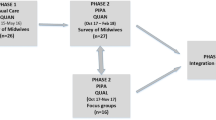Abstract
Objectives
To perform a needs assessment of maternal distress to plan the development of an intervention for the prevention and reduction of antenatal maternal distress.
Methods
We searched PubMed, OVID and EBSCO and applied the PRECEDE logic model to select the data. Experts in the field validated the findings.
Results
We identified 45 studies. Maternal distress was associated with diminished maternal and child’s quality of life. Aetiological factors of maternal distress included past and present circumstances related to obstetric factors and to a woman’s context of living, coping behaviour, and support mechanisms. Lacking knowledge of coping with (maternal) distress was identified as a predisposing factor. Reinforcing factors were relaxation, partner support, counselling experiences and positive interaction with the midwife. Enabling factors were the availability of a support network.
Conclusions
When planning the development of an antenatal intervention for maternal distress, it is advisable to focus on assessment of antenatal emotional wellbeing, the context of the woman’s past and present circumstances, her coping behaviour and her environment. The identified predisposing factors, enabling and reinforcing factors should also be taken into consideration.
Similar content being viewed by others
References
Bartholomew L, Parcel G, Kok G, Gottlieb N, Fernàndez M (2011) Planning health promotion programs. An intervention mapping approach, 3rd edn. Jossey-Bass, San Francisco
Beebe B, Lachmann F, Jaffe J, Merkese S, Buck K, Chen H (2012) Maternal postpartum depressive symptoms and 4-month mother-infant interaction. Psychoanal Psychol 29(4):383–407
Berg M (2005) A midwifery model of care for childbearing women at high risk: genuine caring in caring for the genuine. J Perinat Educ 14(1):9–21
Buist A (2003) Promoting positive parenthood: emotional health in pregnancy. Austral Midwifery J 16(1):10–14
Campbell N, Murray E, Darbyshire J, Emery J, Farmer A, Griffiths F, Guthrie B, Lester H, Wilson P, Kinmonth A (2007) Designing and evaluating complex interventions to improve health. BMJ 334:455–459
Cesario S, Morin K, Santa-Donato A (2002) Evaluating the level of evidence of qualitative research. JOGNN 31:708–714
Cooke M, Schmied V, Sheehan A (2007) An exploration of the relationship between postnatal distress and maternal role attainment, breast feeding problems and breast feeding cessation in Australia. Midwifery 23(1):66–76
Crosby R, Noar S (2011) What is a planning model? An introduction to PRECEDE-PROCEED. J Public Health Dent 71:S7–S15
Cupples M, Stewart M, Percy A, Hepper P, Murphy C, Halliday H (2011) A RCT of peer-mentoring for first-time mothers in socially disadvantaged areas (The MOMENTS-study). Arch Dis Child 96:252–258
Emanuel E, St. John W (2010) Maternal distress: concept analysis. J Adv Nurs 66:2104–2115
Green L, Kreuter M (2005) Health promotion planning: an educational and ecological approach, 4th edn. McGraw-Hill, New York
Green B, Johnson C, Adams A (2006) Writing narrative literature reviews for peer-reviewed journals: secrets of the trade. J Chiropr Med 5(3):101–117
Ickovics J, Reed E, Magriples U, Westdahk C, Schindler Rising S, Kershaw T (2011) Effects of group prenatal care on psychosocial risk in pregnancy: results from a randomised controlled trial. Psychol Health 26:235–250
Jokela M (2010) Characteristics of the first child predict the parents’ probability of having another child. Dev Psychol 46(4):915–926
Jomeen J (2004) The importance of assessing psychological status during pregnancy, childbirth and the postnatal period as a multidimensional construct: a literature review. J Clin Eff Nurs 8:143–155
Jones K (2004) Mission drift in qualitative research, or moving toward a systematic review of qualitative studies, moving back to a more systematic narrative review. Qual Rep 9(1):95–112
Kelly C, Form A, Wright A (2007) Improving mental health literacy as a strategy to facilitate early intervention for mental disorders. MJA 187:S26–S30
KNOV (2010) Advies ontwikkeling wetenschapsdomein fysiologische verloskunde. [Advice for science development of physiological midwifery]. Koninklijke Nederlandse Organisatie van Verloskundigen, Utrecht
Mojtabai R (2010) Mental illness stigma and willingness to seek mental health care in the European Union. Soc Psychiatr Epidemiol 45:705–712
Nast I, Bolten M, Meinlschmidt G, Helhammer D (2013) How to measure prenatal stress? A systematic review of psychometric instruments to assess psychosocial stress during pregnancy. Paediatr Perinat Epidemiol 27:313–322
OCEBM. Oxford centre for evidence-based medicine table of evidence working group (2011) The Oxford 2011 levels of evidence. Oxford, Oxford centre for evidence-based medicine. http://www.cebm.net/index?o=5653. Accessed 28 Jan 2015
PRN (2013) The Netherlands perinatal registry trends 1999–2012. Stichting Perinatale Registratie, Utrecht
Ross-Davie M, Elliot S, Sarkar A, Green L (2006) A public health role in perinatal mental health: are midwives ready? Br J Midwifery 14(6):330–334
Singer L, Fulton S, Davillier M, Koshy D, Salvator A, Baley J (2003) Effects of infant risk status and maternal psychological distress on maternal-infant interactions during the first year of life. J Dev Behav Pediatr 24(4):233–241
Stuurgroep zwangerschap en geboorte (2009) Een goed begin, Adviesrapport. (Dutch Steering Committee Pregnancy and Birth. A Good Beginning, Advisory Report). VWS, The Hague
Svensson J, Barclay L, Cooke M (2009) Randomised-controlled trial of two antenatal education programmes. Midwifery 24:114–125
Van Splunteren P, Franx G, Hermens M (2014) Werken met de vernieuwd zorgp (working with new carep). DeEerstelijns December 12–13
Wright J (2007) A practical guide to assigning levels of evidence. J Bone Joint Surg 89(5):1128–1130
Acknowledgements
This study is part of the research Project “Promoting healthy pregnancy” Funded by Regional Attention and Action for Knowledge (RAAK) (RAAK PRO 2-014).
Author information
Authors and Affiliations
Corresponding author
Rights and permissions
About this article
Cite this article
Fontein-Kuipers, Y., van Limbeek, E., Ausems, M. et al. Responding to maternal distress: from needs assessment to effective intervention. Int J Public Health 62, 441–452 (2017). https://doi.org/10.1007/s00038-016-0910-0
Received:
Revised:
Accepted:
Published:
Issue Date:
DOI: https://doi.org/10.1007/s00038-016-0910-0




